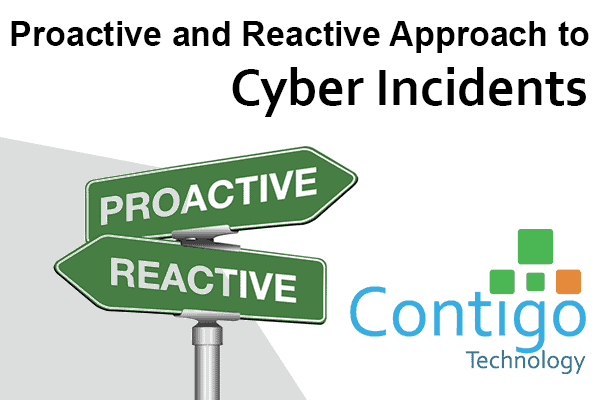
Balancing a Reactive and Proactive Approach to Cyber Incidents
The term cyber incident refers to a security event that can damage companies like yours. These incidents, including system failures, data breaches, and malware attacks, can reduce your organization’s revenue growth, employee productivity, and consumer satisfaction.
Usually, this type of incident results in downtime or data loss, including a loss of customer data, business records, or confidential information. Sometimes, cyber incidents can also trigger financial loss.
Of course, you’ll want to prevent your company from being hacked. After all, just one cyberattack can take away your money, time, and peace of mind. As well as getting system data restored, you must tell all impacted parties that their data could have been compromised. While this is a challenging scenario, this doesn’t mean that it has to be the end of your business.
In this piece, we’ll offer you proactive and reactive approaches which you can take to tackle cyberattacks, survive the aftermath of a hack, and reduce the chance of more incidents occurring.
Proactive steps to implement
By following the proactive steps below, you can protect your company from the challenge of a cyberattack:
Regularly update passwords
It is crucial to routinely update passwords, ensuring that your account is kept safe. Doing this just every six months can assist you in stopping hackers from getting into your account.
If you can’t seem to come up with a strong password, take a look at these top tips:
- Utilize a blend of lowercase and uppercase letters, symbols, and numbers
- Don’t use guessable words, such as your date of birth
- Try to avoid reusing passwords
- Utilize different passwords for each account you have
Utilize a virtual private network
This type of network operates to encrypt your organization’s data and offers you control over who can access it. This can help you dodge data breaches and protect your business information. Despite this, you must ensure that you work with a legitimate provider who can offer you helpful security features.
Complete periodic security awareness training
If you are a responsible company executive, you should make sure that your security awareness training program at work is easy to understand, engaging, and adjustable to new cyber threats. In this current digital age, this is vital to protect any business.
Conduct frequent phishing tests
Phishing refers to a cyberattack which uses underhanded methods to attempt to obtain sensitive user information or trigger users to download some malicious software. These types of attacks can sometimes be highly sophisticated and difficult to detect. This is why it is vital to regularly test your workers, assessing their vulnerability to phishing attacks.
Reset access controls frequently
It is critical to frequently reset access controls to stop unauthorized access to protected resources. This will help ensure that only individuals who are authorized can access sensitive information. Resetting your access controls can be carried out with automated tools or manually.
Utilize multifactor authentication
This security measure requires your workers to give more than just one form of identification when they attempt to access data. This decreases the likelihood of unauthorized data access.
Before we go on, perhaps it is worth mentioning the cybersecurity training topics which are recommended for all small companies by the Small Business Administration:
- Detecting a phishing email
- Utilizing good browsing practices
- Avoiding questionable downloads
- Generating strong passwords
- Protecting sensitive vendor and customer information
- Keeping good cyber hygiene
Reactive steps you should remember
Take a look at the five phases which cover a robust reactive incident response framework:
Identify
When creating an efficient incident response plan, you need to identify security risks. This can include threats to your data, systems, and operations. So, understanding these threats enables you to approach incidents better and decrease the negative impact of security breaches.
Protect
You must construct and implement suitable safeguards when attempting to protect your organization. An example safeguard includes steps you take to maintain the continuity of vital services in an incident scenario.
Detect
Ensure you detect anomalies like suspicious network activity and unauthorized access to any sensitive data. These detections can reduce damage and promptly get your systems back to normal.
Respond
You need to be able to respond effectively to cyber incidents. This approach should involve breach investigation, containment, and resolution methods.
Recover
In order to reduce disruption, you should adopt a plan to continue normal business operations as soon as you can following an incident.
Carrying out the proactive and reactive steps above requires effort, time, and skillsets that may be out of your reach. Despite this, you can still reach your goals in this area by working with an IT service support provider in Austin – like us. Our knowledge and experience in IT service support may be just what you are looking for. Please contact us for a consultation today!
Additionally, if you are seeking more information on incident prevention best practices, download our checklist, “Cyber Incident Prevention Best Practices for Small Businesses”, by clicking here.